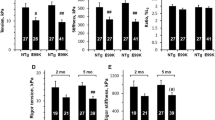Abstract
Cardiac-specific overexpression of murine cardiac calsequestrin results in depressed contractile parameters and hypertrophy in transgenic mice. To determine the long-term consequences of calsequestrin overexpression, the cardiac phenotype of young (2–3-months old) and aged (17 months old) transgenic FVB/N mice was characterized. Ventricular/body weight ratios, which were increased in young transgenics compared with wild-types, were unaltered with age. Left atria of aged transgenics exhibited enlargement and mineralization, but their ventricles did not display fibrosis, mineralization and other injuries. Although echocardiography suggested a time-dependent change in ventricular geometry and loading conditions in vivo, as well as an age-dependent reduction of left ventricular fractional shortening in transgenic mice, Langendorff-perfused hearts of young and aged transgenics indicated that there were no age-related reductions of contractile parameters (±dP/dt). Furthermore, neither genotype nor age altered lung/body weight ratios. Thus, our findings suggest that left ventricular performance in calsequestrin overexpressing mice becomes apparently depressed with age, but this depression is not associated with progressive reduction of left ventricular contractility and heart failure.
Similar content being viewed by others
References
Zhang L, Kelley J, Schmeisser G, Kobayashi YM, Jones LR: Complex formation between junctin, triadin, calsequestrin, and the ryanodine receptor. Proteins of the cardiac junctional sarcoplasmic reticulum membrane. J Biol Chem 272: 23389-23397, 1997
Jones LR, Suzuki YJ, Wang W, Kobayashi YM, Ramesh V, Franzini-Armstrong C, Cleemann L, Morad M: Regulation of Ca2+ signaling in transgenic mouse cardiac myocytes overexpressing calsequestrin. J Clin Invest 101: 1385-1393, 1998
Sato Y, Ferguson DG, Sako H, Dorn GW II, Kadambi VJ, Yatani A, Hoit BD, Walsh RA, Kranias EG: Cardiac-specific overexpression of mouse cardiac calsequestrin is associated with depressed cardiovascular function and hypertrophy in transgenic mice. J Biol Chem 273: 28470-28477, 1998
Cho MC, Rapacciuolo A, Koch WJ, Kobayashi Y, Jones LR, Rockman HA: Defective beta-adrenergic receptor signaling precedes the development of dilated cardiomyopathy in transgenic mice with calsequestrin overexpression. J Biol Chem 274: 22251-22256, 1999
Schmidt AG, Kadambi VJ, Ball N, Sato Y, Kranias EG, Hoit BD: Cardiac specific overexpression of calsequestrin results in left ventricular hypertrophy, depressed force-frequency relation and pulsus alternans in vivo. J Mol Cell Cardiol 32: 1735-1744, 2000
Harding VB, Jones LR, Lefkowitz RJ, Koch WJ, Rockman HA: Cardiac β ARK1 inhibition prolongs survival and augments β blocker therapy in a mouse model of severe heart failure. Proc Natl Acad Sci USA 98: 5809-5814, 2001
Sato Y, Kiriazis H, Yatani A, Schmidt AG, Hahn H, Ferguson DG, Sako H, Mitarai S, Honda R, Mesnard-Rouiller L, Frank KF, Beyermann B, Wu G, Fujimori K, Dorn GW II, Kranias EG: Rescue of contractile parameters and myocyte hypertrophy in calsequestrin overexpressing myocardium by phospholamban ablation. J Biol Chem 2001 276: 9392-9399
Seiler C, Jenni R, Vassalli G, Turina M, Hess OM: Left ventricular chamber dilatation in hypertrophic cardiomyopathy: Related variables and prognosis in patients with medical and surgical therapy. Br Heart J 74: 508-516, 1995
Levy D, Larson MG, Vasan RS, Kannel WB, Ho KK: The progression from hypertension to congestive heart failure. JAMA 275: 1557-1562, 1996
Nichols WW, O'Rourke MF: In: D.A. McDonald (ed). Blood Flow in Arteries: Theoretic, Experimental and Clinical Principles, 3rd edn. Lea & Febiger, Philadelphia, 1990, pp 143-195
McDonald DA (ed): Blood Flow in Arteries, 2nd edn. Williams & Wilkins, Baltimore, 1974, pp 162-164
Luo W, Wolska BM, Grupp IL, Harrer JM, Haghighi K, Ferguson DG, Slack JP, Grupp G, Doetschman T, Solaro RJ, Kranias EG: Phospholamban gene dosage effects in the mammalian heart. Circ Res 78: 839-847, 1996
Meyer M, Schillinger W, Pieske B, Holubarsch C, Heilmann C, Posival H, Kuwajima G, Mikoshiba K, Just H, Hasenfuss G: Alterations of sarcoplasmic reticulum proteins in failing human dilated cardiomyopathy. Circulation 92: 778-784, 1995
Ito K, Yan X, Tajima M, Su Z, Barry WH, Lorell BH: Contractile reserve and intracellular calcium regulation in mouse myocytes from normal and hypertrophied failing hearts. Circ Res 87: 588-595, 2000
Knollmann BC, Knollmann-Ritschel BE, Weissman NJ, Jones LR, Morad M: Remodelling of ionic currents in hypertrophied and failing hearts of transgenic mice overexpressing calsequestrin. J Physiol 525: 483-498, 2000
Sigmund CD: Viewpoint: Are studies in genetically altered mice out of control? Arterioscler Thromb Vasc Biol 20: 1425-1429, 2000
Suzuki YJ, Ikeda T, Shi SS, Kitta K, Kobayashi YM, Morad M, Jones LR, Blumberg JB: Regulation of GATA-4 and AP-1 in transgenic mice overexpressing cardiac calsequestrin. Cell Calcium 25: 401-407, 1999
Nabors CE, Ball CR: Spontaneous calcification in hearts of DBA mice. Anat Rec 164: 153-161, 1969
Eaton GJ, Custer RP, Johnson FN, Stabenow KT: Dystrophic cardiac calcinosis in mice: Genetic, hormonal, and dietary influences. Am J Pathol 90: 173-186, 1978
Ivandic BT, Qiao JH, Machleder D, Liao F, Drake TA, Lusis AJ: A locus on chromosome 7 determines myocardial cell necrosis and calcification (dystrophic cardiac calcinosis) in mice. Proc Natl Acad Sci USA 93: 5483-5488, 1996
van den Broek FAR, Bakker R, den Bieman M, Fielmich-Bouwman AXM, Lemmens AG, van Lith HA, Nissen I, Ritskes-Hoitinga JM, van Tintelen G, van Zutphen LFM: Genetic analysis of dystrophic cardiac calcification in DBA/2 mice. Biochem Biophys Res Commun 253: 204-208, 1998
Sacchetto R, Turcato F, Damiani E, Margreth A: Interaction of triadin with histidine-rich Ca2+-binding protein at the triadic junction in skeletal muscle fibers. J Muscle Res Cell Motil 20: 403-415, 1999
Meyer M, Trost SU, Bluhm WF, Knot HJ, Swanson E, Dillmann WH: Impaired sarcoplasmic reticulum function leads to contractile dysfunction and cardiac hypertrophy. Am J Physiol 280: H2046-H2052, 2001
Author information
Authors and Affiliations
Rights and permissions
About this article
Cite this article
Sato, Y., Schmidt, A.G., Kiriazis, H. et al. Compensated hypertrophy of cardiac ventricles in aged transgenic FVB/N mice overexpressing calsequestrin. Mol Cell Biochem 242, 19–25 (2003). https://doi.org/10.1023/A:1021196402952
Issue Date:
DOI: https://doi.org/10.1023/A:1021196402952




